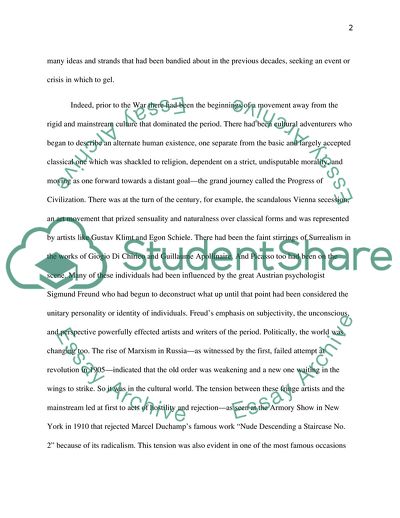Cite this document
(Crisis of Confidence in the Poetry of the Twentieth Century Assignment, n.d.)
Crisis of Confidence in the Poetry of the Twentieth Century Assignment. https://studentshare.org/literature/1717822-poetry-in-the-twentieth-century-reflects-a-growing-crisis-of-confidence-in-a-society-within-which-values-were-rapidly-becoming-unstable-discuss-this-comment-using-at-least-two-poems-by-two-different-poets-chosen-from-wb-yeats-edward-thomas-ts-elliott
Crisis of Confidence in the Poetry of the Twentieth Century Assignment. https://studentshare.org/literature/1717822-poetry-in-the-twentieth-century-reflects-a-growing-crisis-of-confidence-in-a-society-within-which-values-were-rapidly-becoming-unstable-discuss-this-comment-using-at-least-two-poems-by-two-different-poets-chosen-from-wb-yeats-edward-thomas-ts-elliott
(Crisis of Confidence in the Poetry of the Twentieth Century Assignment)
Crisis of Confidence in the Poetry of the Twentieth Century Assignment. https://studentshare.org/literature/1717822-poetry-in-the-twentieth-century-reflects-a-growing-crisis-of-confidence-in-a-society-within-which-values-were-rapidly-becoming-unstable-discuss-this-comment-using-at-least-two-poems-by-two-different-poets-chosen-from-wb-yeats-edward-thomas-ts-elliott.
Crisis of Confidence in the Poetry of the Twentieth Century Assignment. https://studentshare.org/literature/1717822-poetry-in-the-twentieth-century-reflects-a-growing-crisis-of-confidence-in-a-society-within-which-values-were-rapidly-becoming-unstable-discuss-this-comment-using-at-least-two-poems-by-two-different-poets-chosen-from-wb-yeats-edward-thomas-ts-elliott.
“Crisis of Confidence in the Poetry of the Twentieth Century Assignment”. https://studentshare.org/literature/1717822-poetry-in-the-twentieth-century-reflects-a-growing-crisis-of-confidence-in-a-society-within-which-values-were-rapidly-becoming-unstable-discuss-this-comment-using-at-least-two-poems-by-two-different-poets-chosen-from-wb-yeats-edward-thomas-ts-elliott.


